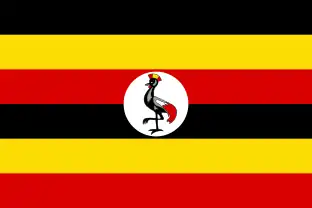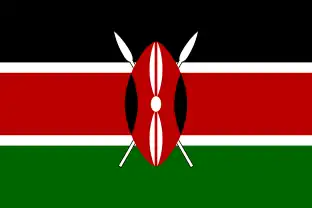Teso people
The Iteso (or people of Teso) are a Nilotic ethnic group in eastern Uganda and western Kenya. Teso refers to the traditional homeland of the Iteso, and Ateso is their language.[4]
| Part of a series on the |
| Culture of Uganda |
|---|
 |
| People |
| Languages |
| Cuisine |
| Religion |
| Music |
| Sport |
| Part of a series on the |
| Culture of Kenya |
|---|
 |
| Cuisine |
| Total population | |
|---|---|
| 2,782,239 | |
| Regions with significant populations | |
| 2,364,569[1][2] | |
| 417,670[3] | |
| Languages | |
| Teso language, English language | |
| Religion | |
| Christianity, Traditional faith | |
| Related ethnic groups | |
| other Ateker peoples and other Nilotic peoples | |
| Teso | |
|---|---|
| Person | Etesot (m)/Atesot (f) |
| People | Iteso |
| Language | Ateso |
| Country | Teso |
History
Origins
The exact origins of the Iteso remain unclear. Iteso oral tradition holds that they had migrated south from Sudan over centuries at some indeterminate time in the past. Others have proposed an origin in Ethiopia, while others think that the Iteso split off from the Karamojong.[5] If the last theory is true, this supposed split likely happened quite early considering the lack of similar cultural rituals and naming conventions between the two groups.[6] However, there are notable cultural ties and linguistic similarities between the two groups; the word "Karamojong" literally means "the old ones who stayed behind."[7]
Migration
It's believed there were two waves of migration. The first migration brought them to present day northeastern Uganda and western Kenya and was largely gradual and peaceful. The legendary hero Oduk and his wife Among'in supposedly helped the Iteso in this second migration to modern day Busia County circa 1500 AD, and by the 19th century, they controlled a vast swathe of territory. Their aggressive expansion drew them into conflicts with other already present ethnic groups. Oduk is credited with militarily organizing the Iteso and helping them defeat their rivals.[8] However, their gains were reversed as neighboring ethnic groups allied with the British defeated them. Much of traditional Iteso culture and organization was lost when they were conquered by the Ganda people in the 19th century;[9] the language of the northern Ateso is markedly influenced by Luganda due to this conquest. In contrast, southern Ateso has been influenced by the Turkana language.
British colonialism and independence
During the 20th century, the Iteso people underwent drastic changes in their lifestyles, transitioning from a pastoral lifestyle to prolific farmers.[10] Many Iteso men travelled abroad to work in overseas British territories, such as Burma. In 1902, part of eastern Uganda was transferred to western Kenya, splitting the Iteso; despite this division, there's little cultural difference between the two.[11] However, the two's economic and social paths have diverged greatly. At independence, Ugandan Iteso were wealthier, as they did not suffer from the economic marginalization Kenyan Africans did due to white settlers. However, the Kenyan Iteso did not suffer the same degree of political instability their Ugandan cousins have, and Kenya's more developed economic infrastructure allowed for Kenyan Iteso to overtake Ugandan Iteso in wealth.
During Milton Obote's first period of rule, many Iteso received army and administration posts, allowing them to gain relative prosperity, which they invested back into cattle herds.[12] After Idi Amin was overthrown in 1979, the Karamojong acquired large amounts of arms, which they used to raid cattle from largely unarmed Iteso civilians; Iteso cattle herds were decimated, and many fell into poverty. During Obote's second period of rule, the Ugandan army was composed largely of the Iteso and Acholi. When Yoweri Museveni came to power, he disbanded a military unit meant to stop the Karamojong's cattle rustling and dismissed many Iteso, Acholi, and Kumam soldiers from the army for their previous service under Obote.[12] These disgruntled soldiers, upon returning to their economically deprived homelands due to violent cattle raids, took up arms against the Museveni regime. The Teso insurgency lasted into the late 1980s, keeping the region undeveloped.[7][12]
In 1992, the conflict was brought to an end through the combined effort of the local initiatives, indigenous mediators, churches, and the Presidential Commission for Teso (PCT). This led to the creation of a war memorial near the Iteso capital Soroti, and the installation of a Iteso king, Emorimor Papa Paphrus Imodot Edimu. While successful in ending the violence and mollifying Teso opposition to Museveni, the Teso sub-region remains one of the poorest regions in Uganda, and the Iteso feel politically and economically neglected, widely distrusting the Museveni administration.[12]
Distribution
Uganda
In Uganda, the Iteso live mainly in Teso sub-region, i.e., the districts of Amuria, Bukedea, Butebo, Kaberamaido, Kapelebyong, Katakwi, Kumi, Ngora, Serere and Soroti, but are also found in Bugiri and Pallisa, as well as in the Tororo and Busia districts.
According to the 2014 Ugandan Bureau of Statistics report, the Iteso number about 2.36 million (7.0% of Uganda's population).[13] Until 1980, they were the second largest ethnic group in Uganda; this share of the population likely decreased due to Teso fleeing from political instability and violence.[14] Some Iteso contend that they are still the second largest ethnic group in Uganda, and this figure has supposedly been deflated to restrict the political power of the Iteso, as the national budget is distributed based on population.[12]
Kenya
There are around 578,000 Iteso in Kenya, living mainly in Busia County, south of Mt. Elgon. They primarily inhabit two sub-counties, Teso North and Teso South, but can be found in Bugoma and Trans Nzoia County.
Economic activities
Farming
The Iteso are noted for their quick adoption of the ox plow in the early 1900s.[9] Women farmed and foraged while men herded their cattle.[6]
Cotton is the primary cash crop among the Iteso.[9] It's grown by both men and women in separate plots during the short rains. Another cash crop grown is tobacco.[6] In the 1980s, Kenyan government-sponsored cooperative-ran cotton ginneries failed to pay for the cotton delivered by the Iteso and others. The Iteso then began experimenting with other cash crops like tobacco with the aid of loans from large agricultural companies. However, since the 1990s, the cotton industry has been partially revived.[6]
Herding
Herding used to be the primary economic activity among the Iteso, particularly men.[6] Cattle play a large social role among the Iteso, as they play a key role in negotiating bride-price and other important social events. When a father gives a son his own cattle, it signals the maturation of the son, able to manage his own estate and start his own family.[7]
Culture
Cuisine
The staple food for the Iteso is finger millet ('akima') and sorghum ('imomwa').[15] During colonization, cassava was introduced by colonial authorities as a dietary supplement.[6] They also consume pumpkins, wild berries, peas, groundnuts, and beans. Domestic and wild animal meat was consumed, alongside milk, butter, and fish.[5]
The cultural drink of the Iteso people is 'ajon', a fermented brew made from dried finger millet (usually the emiroiti variety) that is commonly consumed in local ceremonies, social gatherings and important events. It can be consumed in a calabash, or a communal pot where participants sip the drink from long tubes.[16][17] It is custom to keep a mother whose recently given birth confined to the home for three days, and afterwards, ajon is placed in the mouth of the infant. Some Christian Iteso criticize the customs surrounding ajon.[17] In the modern age, the production of ajon has become commercialized, and its production and sale are an important source of income for the families that specialize in making it.[16]
Afterlife
According to oral tradition, the legendary Oduk was responsible for the Iteso practice of exhuming bodies from bushes after a number of years.[8] The Iteso traditional religion holds that upon death, the body is separated from its spirit ('eparait'), which leaves to live in the bush. Ideally, the spirit will move further and further into the bush, but discontent spirits may return to bother the living, demanding offerings of food and drink.[18] Exhuming the bodies after a few years is meant to 'cool' them, and make them more amenable to the living. Many Iteso are reluctant or even afraid to be buried in coffins, believing they cannot be 'cooled', and thereby suffocating the dead.[18]
Due to missionary influence, spirits of the dead have come to be associated with ajokin, small creatures of the bush, and both have come to be associated with the devil.[18]
Religion
Prior to European missionary efforts, the Iteso believed in an omnipotent god called Akuj, and a God of calamity called Edeke.[9]
Notable people
- Jessica Alupo, Current Vice President of the Republic of Uganda
- Anita Annet Among, Current Speaker of Parliament of Uganda
- Jeje Odongo, Current Minister of Foreign Affairs
- Christine Apolot, Ugandan politician
- Sospeter Ojaamong, Kenyan politician
- John Bosco Ikojo, Ugandan politician
- Kevin Ojinga Kaala, Ugandan politician
- Mike Mukula, Ugandan politician
- Musa Francis Ecweru, State Minister for Works and transport in the Ugandan Cabinet
- Enoch Olinga, Prominenet member of the Baha'i Faith, Knight of Baháʼu'lláh and was appointed as the youngest Hand of the Cause
- Olubayi Olubayi, board member of Kiwimbi Organisation
- Patricia Apolot, Ugandan female professional martial artist
- Proscovia Alengot Oromait, Ugandan politician. At age 19, she was the youngest Member of Parliament in Uganda and in Africa.
- Silas Aogon, Ugandan politician
- Shaban Opolot, Ugandan military officer
- Ferdinand Omurwa, Kenyan sprinter
- Peter Elwelu (Major General), Current Ugandan Deputy Chief of Defence Forces.
References
- Uganda Bureau of Statistics. "National Population and Housing Census 2014 - Main Report" (PDF).
- "Uganda". World Directory of Minorities and Indigenous Peoples.
- "2019 Kenya Population and Housing Census Volume IV: Distribution of Population by Socio-Economic Characteristics". December 2019.
- Karp, Ivan (1978). Fields of Change among the Iteso of Kenya. Routledge; Reprint edition (2005). ISBN 0-415-32990-6.
- "Teso" (PDF). National African Language Resource Center.
- bwindigorilla (1 November 2021). "Teso People | Iteso People and their culture in Uganda and Kenya". Bwindi Forest National Park. Retrieved 2 November 2021.
- "Ben Jones: The 1980s weakening of Uganda's security infrastructure helped cause the Teso insurgency". the Guardian. 24 February 2009. Retrieved 2 November 2021.
- "Oduk: The Story of the Iteso Conqueror". Google Arts & Culture. Retrieved 2 November 2021.
- "Teso | people". Encyclopedia Britannica. Retrieved 2 November 2021.
- Kennedy, F. R (1937). Teso clans. National Archives: The Uganda Journal.
- Mwakikagile, Godfrey (2009). Ethnicity and National Identity in Uganda: The Land and Its People. New Africa Press. ISBN 978-9987-9308-7-6.
- Buckley-Zistel, Susanne (2008), "Effective History and the Beginning of the Teso Insurgency", Conflict Transformation and Social Change in Uganda, Palgrave Macmillan UK, pp. 54–73, doi:10.1057/9780230584037_4, ISBN 978-1-349-35930-1, retrieved 30 May 2020
- The National Population and Housing Census 2014. Kampala, Uganda: Uganda Bureau of Statistics. 2014. p. 20.
- Buckley-Zistel, Susanne, 1969- (2008). Conflict transformation and social change in Uganda remembering after violence. Palgrave Macmillan. ISBN 978-0-230-58403-7. OCLC 1131998608.
{{cite book}}: CS1 maint: multiple names: authors list (link) - Uganda: From Earth to Table - Traditional Products and Dishes. Slow Food International. 2018. p. 7.
- "Uganda/Teso: Ajon – The Beginning & The End Of Every Celebration". Comboni Missionaries. 21 September 2018. Retrieved 2 November 2021.
- Uganda: From Earth to Table - Traditional Products and Dishes. Slow Food International. 2018. p. 23.
- "Iteso People and their culture". Retrieved 2 November 2021.